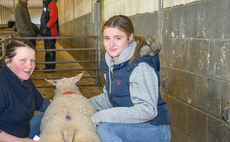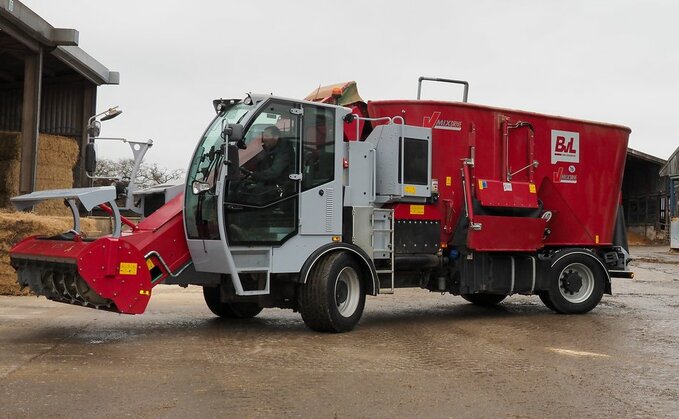
The latest BvL self-propelled feeder wagon is at work on a Cheshire dairy farm, but it has been quite a journey. Jane Carley reports finds out how the new machine is fitting in on-farm.
A reassessment of the best feeding solution for a large dairy herd and a young stock unit on two separate sites in Cheshire eventually led Lachstone Farms to the purchase of a BvL self-propelled mixer wagon. The business, which produces for Sainsbury's via Mueller on farms near Middlewich, averages 11,900 litre yields.
"We needed to replace our trailed mixer, but due to business expansion we would also have needed a new tractor to pull it, which would have been shared with other jobs, so you end up with someone always waiting for the tractor," says farm manager Steve Moses. "We are now feeding twice a day, so it would have led to serious issues at silaging time."
Depreciation of the tractor, mixer wagon and wheeled loader also needed to be taken into consideration, points out business owner Jeremy Platt.
Mr Moses says: "The JCB can do 1,500-1,600 hours a year including loading the mixer wagon; taking it out of the operation frees it up for other jobs and prolongs its life."
He adds that they also saw the opportunity to reduce waste when loading and increase accuracy. "There is always some waste when you use a bucket, and no two bucket loads are the same. With the milling head on a self-propelled machine, exactly the right amount goes into the tub," says Mr Moses.
Self-propelled mixers on local farms were studied and Mr Moses drove another brand, but the more central driving position of the BvL cab and option of a 40kph transmission helped to make the decision.
"It is not far between the two units but we go back and forward several times every day, so we need machines that are good on the road," he comments. "We took some convincing. It was not until we had driven a self-propelled machine that we believed it could actually work for us.
Mr Platt says: "It is very important that the operators like to use the machine, in order for us to get the best out of it, so the demonstration was a key step."
With a trailed mixer also up for replacement at the business's second farm, an hour's drive away, simply replacing with two new trailed machines or even looking for a larger self-propelled mixer wagon to cover all the units was also under consideration - the latter ruled out due to the distances involved and extra labour requirement.
"It costs around £20-22/hour to operate, so travelling to the other farm would involve spending £42/day just on transport," says Mr Platt.
Arriving at the start of this year, the self-propelled machine is still very much in its early days. Powered by a 224hp FPT Stage 5 engine, the BvL V-Mix Drive Maximus 21-2S is the first of its kind in the UK, but so far is performing well. A key feature is the milling head which uses Hardox tines to ‘rake' silage out of the clamp, rather than blades to chop it out, says Mr Platt.
"The difference can be seen in the very clean face of the clamp, which minimises any spoilage that occurs with a loader-mounted grab. Even with a shear grab, when a block is taken from the face, the next section is lifted slightly, allowing air in and leading to secondary fermentation.
"It is also far more accurate than adding ingredients with a bucket which means that the herd is getting a consistent diet, which seems to be benefiting health and productivity already."
Ingredients are transported to the 21cu.m tub via a conveyor and mixed using twin augers before being distributed via a 1,100mm wide side door or cross conveyor.
Mr Moses says: "We have some troughs at our young stock unit, so it is useful to have a conveyor, although most of the feed goes through the door and is placed along the feed fence."
An additional rear door allows blends to be premixed from bulk stocks before collection via the milling head; there is also a small hopper on the side of tub for adding high value minerals.
Buildings at both sites are mainly modern and spacious, but with the machine measuring 9.63m long and 2.4m wide, four-wheel steer comes in handy, while four-wheel drive helps with grip in the wet. The Maximus Plus has also been specified with air suspension.
The hopper is stainless steel lined to increase longevity; other additions include a spotlight to illuminate the feed discharge area. A three-phase power input to the rear of the cab allows engine and hydraulic oil to be pre-warmed before starting.
Rations are uploaded onto BvL's Dairy Manager controller from the farm office via the ‘cloud', and this also monitors loading, weighing the ingredients in and providing an alert when the selected quantity is loaded. It is an established BvL system, so the operators were already familiar with it. Operation is via a single joystick and a dial which selects whether it is used in loading, driving or unloading mode.
"It is very straightforward, generally myself or another operator use it, but my son acts as relief driver and was able to get straight on and operate it," comments Mr Moses. "The main challenge is to get used to looking in the mirror to monitor the feed discharge.
"It is also flexible. In a group of heifers, we can split them in half and feed the older ones a different ration. It is easy to go and get some more concentrates as there is no need to get in and out of the cab to load the tub and you know that you are adding exactly the right amount."

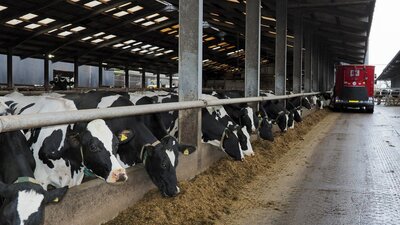
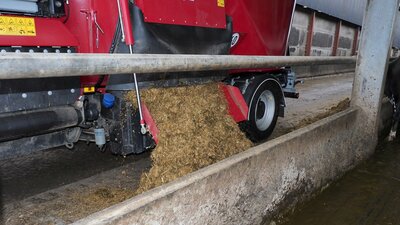

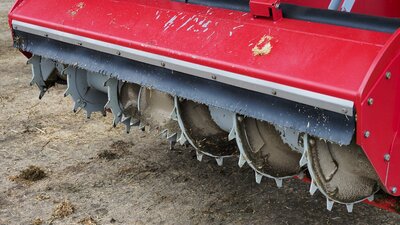
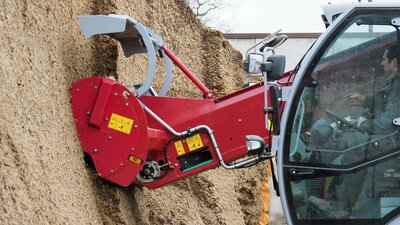
Head
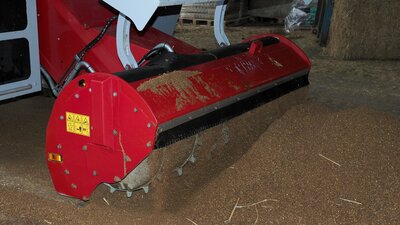
The head can also be used to gather loose materials such as concentrates, pre-mixed in the tub and laid in a windrow via the rear door (pictured below).
Rear door
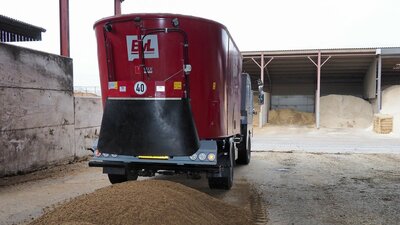
Hopper
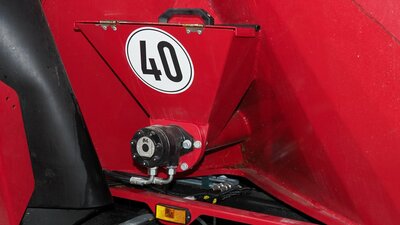
A small hopper allows high value minerals to be loaded directly into the tub.
People

BvL's John Molton with farm manager Steve Moses and business owner Jeremy Platt.
Machine detail
- Model: BvL V-Mix Drive Maximus Plus 2S 21
- Engine: Six-cylinder, FPT, Stage 5, 224hp, with optional Cleanfix reversible radiator
- Transmission: Hydrostatic, 40kph, four-wheel steer and four-wheel drive option
- Capacity: 21cu.m, featuring stainless steel lined tub option
- Number of mixing augers: Two
- Unloading: 1,100mm left hand door and optional cross conveyor
- Cameras: rear and tub mounted
- Cab: heating and ventilation, air suspended Grammar seat, radio, Dairy Manager feeding system
- Dimensions (L by W by H): 9.8m by 2.45m by 2.89m
- Maximum payload: 18 tonnes
- Unladen weight: 14.9 tonnes
- Retail price: £200,000
Verdict
Feeding 520 milking cows, 60 dry cows, 30 transition cows and 450 young stock, the Maximus Giant does 10 rounds in the morning and three in the afternoon.
It is early days for assessing running costs, but Mr Moses comments that fuel usage is 22-25 litres/hour when the engine is working hardest, milling grass silage. Auto-lubrication makes light work of maintenance and 500 hour services will be handled by dealer RW Pugh, which also holds a stock of parts, many of which are common to the trailed machines. The milling head's Hardox tines are expected to last a year, although spares are suppled in case of breakages.
An appealing proposition for the Maximus Plus's future is offered by BvL's established demand for used machines, especially at about 5,000 hours or five years old, says Mr Platt. "We had already worked out the resale value at 6,000 hours, but as the machine is going to put in 2,000 hours a year, we will reach that point in three years. BvL has suggested that there will be interest in it, so it is definitely something to think about."




















